

Multi, inter, Transdisciplinarity... 6-Collective Intelligence. Culturomics. K.I.S.S. Picbreeder. EndlessForms.com - Design objects with evolution and 3D print them! How to Create a Mind - Homepage. HyperNEAT User's Page. Neuroevolution of augmenting topologies. NeuroEvolution of Augmenting Topologies (NEAT) is a genetic algorithm for the generation of evolving artificial neural networks (a neuroevolution technique) developed by Ken Stanley in 2002 while at The University of Texas at Austin.

It alters both the weighting parameters and structures of networks, attempting to find a balance between the fitness of evolved solutions and their diversity. It is based on applying three key techniques: tracking genes with history markers to allow crossover among topologies, applying speciation (the evolution of species) to preserve innovations, and developing topologies incrementally from simple initial structures ("complexifying"). Performance[edit] On simple control tasks, the NEAT algorithm often arrives at effective networks more quickly than other contemporary neuro-evolutionary techniques and reinforcement learning methods.[1][2] Complexification[edit] Implementation[edit] Extensions to NEAT[edit] rtNEAT[edit] Phased Pruning[edit] HyperNEAT[edit] Playing with Chance: On Random Generation in Playable Media and Electronic Literature.
The standard line on the conceptual status of the aleatory in the world of electronic literature is strikingly demonstrated by Daniel C.
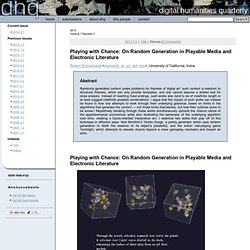
Mobilizing Knowledge through Complex Systems. World Summit on the Information Society. GAC_PerspectivesHyperconnectedWorld_ExecutiveSummary_2013.pdf (Objet application/pdf) ACE. Searching Without Objectives. Bio Kenneth O.
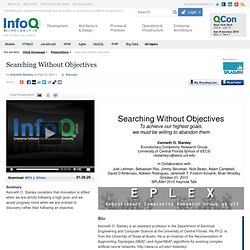
Stanley is an assistant professor in the Department of Electrical Engineering and Computer Science at the University of Central Florida. The Archive is a Campsite. I help run a site, Longform, that collects great non-fiction, past and present.

Every day, we post links to four pieces, emphasizing evergreen interest over current events. The articles come from magazines well-known and obscure—it’s a straightforward project that serves audiences simply looking for something to read. Internet use 'good for the brain' For middle-aged and older people at least, using the internet helps boost brain power, research suggests.

A University of California Los Angeles team found searching the web stimulated centres in the brain that controlled decision-making and complex reasoning. The researchers say this might even help to counteract the age-related physiological changes that cause the brain to slow down. The study features in the American Journal of Geriatric Psychiatry. As the brain ages, a number of changes occur, including shrinkage and reductions in cell activity, which can affect performance.
It has long been thought that activities which keep the brain active, such as crossword puzzles, may help minimise that impact - and the latest study suggests that surfing the web can be added to the list. Lead researcher Professor Gary Small said: "The study results are encouraging, that emerging computerised technologies may have physiological effects and potential benefits for middle-aged and older adults. Meta-Optimizing Semantic Evolutionary Search. Meta-optimizing semantic evolutionary search (MOSES) is a new approach to program evolution, based on representation-building and probabilistic modeling.
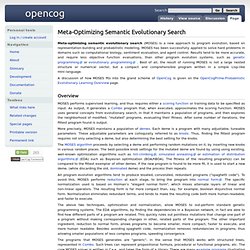
MOSES has been successfully applied to solve hard problems in domains such as computational biology, sentiment evaluation, and agent control. Results tend to be more accurate, and require less objective function evaluations, than other program evolution systems, such as genetic programming or evolutionary programming . Cognition. 6 thinking hats. What It needs. CoLab & CoIntel Tool Box. Gamification. How to Build a Collective Intelligence Platform to Crowdsource Almost Anything. Introduction The MIT Center for Collective Intelligence recently published an important overview of the theory and mechanisms behind successful crowdsourcing efforts.
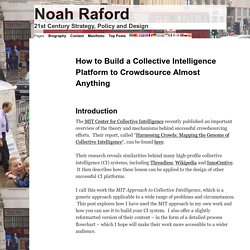
OpenCog. OpenCog is a unique and ambitious open-source software project.
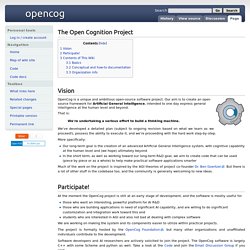
Our aim is to create an open source framework for Artificial General Intelligence, intended to one day express general intelligence at the human level and beyond. That is: We're undertaking a serious effort to build a thinking machine. Dynamical Psychology » Dynamical Psychology: An International, Interdisciplinary Journal of Complex Mental Processes. Les traîtres à la cause. Internet devait nous aider à changer le monde, vite.
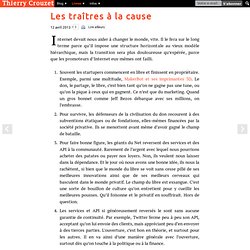
Il le fera sur le long terme parce qu’il impose une structure horizontale au vieux modèle hiérarchique, mais la transition sera plus douloureuse qu’espérée, parce que les promoteurs d’Internet eux-mêmes ont failli. Souvent les startupers commencent en libre et finissent en propriétaire. Exemple, parmi une multitude, MakerBot et ses imprimantes 3D. Le don, le partage, le libre, c’est bien tant qu’on ne gagne pas une tune, ou qu’on la pique à ceux qui en gagnent. Ce n’est que du marketing. Moi-même je ne suis pas clair. Je leur reproche plus encore de prétendre œuvrer pour la société du partage alors qu’ils la maltraitent tous les jours davantage. Mini manuel de lutte Naviguer avec des filtres antipub comme AdBlock. Tags: slow connexion, une, Coup de gueule. Rémunérer les amateurs pour valoriser les externalités positives. Il y a quelques jours, Rue89 a publié un entretien avec Bernard Stiegler, directeur de l’IRI (Institut de Recherche et d’Innovation), intitulé "Nous entrons dans l’ère du travail contributif".
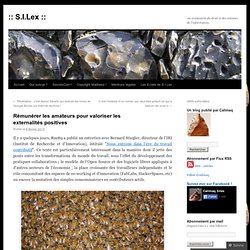
Perfection Game. Mastermind-matrix.gif (1045x742) From Gamification to Intelligence Amplification to The Singularity. “Moore’s law became obsolete as far as graphics were concerned. American Society for Cybernetics - Index. Computing in the net of possibilities. Collaborative innovation network. A Collaborative Innovation Network, or CoIN, is a social construct used to describe innovative teams[clarification needed]. It has been defined by the originator of the term, Peter Gloor (a Research Scientist at MIT Sloan's Center for Collective Intelligence) as "a cyberteam of self-motivated people with a collective vision, enabled by the Web to collaborate in achieving a common goal by sharing ideas, information, and work. " Overview[edit] COINs feature internal transparency and direct communication. Why you should apply Living Systems Theory to Social Network Design. Autopoiesis is the word! I have introduced the theory of living systems developed by Maturana and Varela (technically known as autopoiesis) in previous articles.